Synthesis and Thermotropic Studies of a New Series of Teraryl Liquid Crystals 2-(4'-Alkoxybiphen-4-yl)-5-Cyanopyridines
Abstract
:1. Introduction
2. Results and Discussion
2.1. Synthesis
2.2. Thermotropic Studies
3. Experimental Section
3.1. General
3.2. Synthesis
3.2.1. Representative procedure for the homologues of 2-(4′-alkoxybiphen-4-yl)-5-cyanopyridines (nO-PPPyCN, n = 2–8)
3.2.1.1. 2-(4-Ethoxybiphen-4′-yl)-5-cyanopyridine (2O-PPPyCN)
3.2.1.2. 2-(4-propoxybiphen-4′-yl)-5-cyanopyridine (3O-PPPyCN)
3.2.1.3. 2-(4-butoxybiphen-4′-yl)-5-cyanopyridine (4O-PPPyCN)
3.2.1.4. 2-(4-pentoxybiphen-4′-yl)-5-cyanopyridine (5O-PPPyCN)
3.2.1.5. 2-(4-hexoxybiphen-4′-yl)-5-cyanopyridine (6O-PPPyCN)
3.2.1.6. 2-(4-heptoxybiphen-4′-yl)-5-cyanopyridine (7O-PPPyCN)
3.2.1.7. 2-(4-octoxybiphen-4′-yl)-5-cyanopyridine (8O-PPPyCN)
4. Conclusions
Acknowledgments
Conflicts of Interest
References
- Sluckin, T.J.; Dunmur, D.A.; Stegemeyer, H. Crystals That Flow; Gray, G.W., Goodby, J.W., Fukuda, A., Eds.; Taylor & Francis: London, UK, 2004; pp. 3–21. [Google Scholar]
- Nash, J.A.; Gray, G.W. Studies of some heterocyclic mesogens. Mol. Cryst. Liq. Cryst 1974, 25, 299–321. [Google Scholar]
- Burrow, M.P.; Gray, G.W.; Lacey, K.J. The synthesis and liquid crystal properties of some 2,5-disubstituted pyridines. Liq. Cryst 1988, 3, 1643–1653. [Google Scholar]
- Gray, G.W. Advances in Liquid Crystals; Brown, G.H., Ed.; Academic Press: New York, NY, USA, 1976; Volume 2. [Google Scholar]
- Hird, M.; Gray, G.W.; Toyne, K.J. Cross-coupling reactions in the synthesis of liquid crystals. Mol. Cryst. Liq. Cryst 1991, 206, 187–204. [Google Scholar]
- Karamysheva, L.A.; Kovshev, E.I.; Pavluchenko, A.I.; Roitman, K.V.; Titov, V.V.; Torgova, S.I.; Grebenkin, M.F. New heterocyclic liquid crystalline compounds. Mol. Cryst. Liq. Cryst 1981, 67, 241–252. [Google Scholar]
- Grebenkin, M.F.; Petrov, V.F.; Belyaev, V.V.; Pavluchenko, A.I.; Smirnova, N.I.; Kovshev, E.I.; Titov, V.V.; Ivashchenko, A.V. Synthesis and properties of 5-alkyl-2-(4-cyanophenyl)pyridines. Mol. Cryst. Liq. Cryst 1985, 129, 245–257. [Google Scholar]
- Pavlyuchenko, A.I.; Smirnova, N.I.; Mikhailova, T.A.; Kovshev, E.I.; Titov, V.V. Synthesis of 2-(4-alkylphenyl)- and 2-(4-alkoxyphenyl)-5-cyanopyridines and their liquid-crystal characteristics. Zh. Org. Khim 1986, 22, 1061–1065. [Google Scholar]
- Kelly, S.M.; Funfschilling, J.; Villiger, A. Smectic C phenylpyridines with an alkenyloxy chain. Liq. Cryst 1993, 14, 1169–1180. [Google Scholar]
- Kelly, S.M.; Funfschilling, J. Novel 2-(4-octylphenyl)pyridine-5-yl alkanoates and alkenoates: Influence of dipoles and chain conformation on smectic C formation. Liq. Cryst 1996, 20, 77–93. [Google Scholar]
- Getmanenko, Y.A.; Twieg, R.J.; Ellman, B.D. 2,5-Dibromopyridine as a key building block in the synthesis 2,5-disubstituted pyridine-based liquid crystals. Liq. Cryst 2006, 33, 267–288. [Google Scholar]
- Asano, T.; Uenoyama, M.; Moriya, K.; Yano, S.; Takatani, S.; Kagabu, S. Polymorphism in a homologous series of 2-(4-alkoxyphenyl)-5-(4-methylphenyl)pyridines. Liq. Cryst 1997, 23, 365–369. [Google Scholar]
- Asano, T.; Moriya, K.; Yano, S.; Takatani, S.; Kagabu, S. Liquid crystalline phase transitions of the 2-(4′-alkoxybiphenyl-4-yl)-5-(4-methylphenyl)pyridines. Liq. Cryst 1998, 25, 263–266. [Google Scholar]
- Moriya, K.; Harada, F.; Yano, S.; Kagabu, S. The synthesis and liquid crystalline behaviour of 2-(4-n-alkoxyphenyl)-5-methylpyridines. Liq. Cryst 2000, 27, 1647–1651. [Google Scholar]
- Molander, G.A.; Ellis, N. Organotrifluoroborates: Protected boronic acids that expand the versatility of the Suzuki coupling reaction. Acc. Chem. Res 2007, 40, 275–286. [Google Scholar]
- Molander, G.A.; Canturk, B.; Kennedy, L.E. Scope of the Suzuki-Miyaura cross-coupling reactions of potassium heteroaryltrifluoroborates. J. Org. Chem 2009, 74, 973–980. [Google Scholar]
- Tietz, J.I.; Mastriana, J.R.; Sampson, P.; Seed, A.J. Novel 5-(4-alkoxyphenyl)thienol[3,2-b] thiophene-2-carboxylate esters: Highly efficient synthesis and mesogenic evaluation of a new class of materials exhibithing the smectic C phase. Liq. Cryst 2012, 39, 515–530. [Google Scholar]
- Chia, W.L.; Shen, S.W.; Lin, H.C. Novel synthesis of liquid crystalline compounds of 5-substituted 2-(4-alkylphenyl)pyridines. Tetrahedron. Lett 2001, 42, 2177–2179. [Google Scholar]
- Chia, W.L.; Cheng, Y.W. Facile synthesis of a series of 2-(4-alkyloxyphenyl)-5-cyanopyridine liquid crystalline compounds. Heterocycles 2008, 75, 375–382. [Google Scholar]
- Chia, W.L.; Li, C.L.; Lin, C.H. Synthesis and mesomorphic studies on the series of 2-(4-alkoxyphenyl)-5-phenylpyridines and 2-(6-alkoxynaphthalen-2-yl)-5-phenylpyridines. Liq. Cryst 2010, 37, 23–30. [Google Scholar]
- Chia, W.L.; Tsai, C.Y. Synthesis and mesomorphic properties of a series of phenyl 6-(4-alkoxyphenyl)nicotinates. Heterocycles 2011, 83, 1057–1065. [Google Scholar]
- Comins, D.L.; Abdullah, A.H. Regioselective addition of Grignard reagents to 1-acylpyridinium salts. A convenient method for the synthesis of 4-alkyl(aryl)pyridines. J. Org. Chem 1982, 47, 4315–4319. [Google Scholar]
- Comins, D.L.; Stroud, E.D.; Herrick, J.J. Regioselective addition of Grignard reagents to the 1-phenoxycarbonyl salts of alkyl nicotinates. Heterocycles 1984, 22, 151–157. [Google Scholar]
- Gray, G.W.; Mosley, A. Trends in the nematic-isotropic liquid transition temperatures for the homologous series of 4-n-alkoxy and 4-n-alkyl-4′ cyanobiphenyls. J. Chem. Soc. Perkin. II 1976, 1, 97–102. [Google Scholar]
- Imrie, C.T.; Taylor, L. The preparation and properties of low molar mass liquid-crystals possessing lateral alkyl chains. Liq. Cryst 1989, 6, 1–10. [Google Scholar]
- Donaldson, T.; Staesche, H.; Lu, Z.B.; Henderson, P.A.; Achard, M.F.; Imrie, C.T. Symmetric and non-symmetric chiral liquid crystal dimers. Liq. Cryst 2010, 37, 1097–1110. [Google Scholar]
- Zang, Z.Q.; Zhang, D.D.; Wan, X.H.; Zhou, Q.F. The synthesis and property of liquid crystalline 4-alkoxyl-4′-cyano-p-terphenyls. Mol. Cryst. Liq. Cryst 2000, 339, 145–158. [Google Scholar]
- Coates, D. Chemical Structure, Molecular Engineering and Mixture Formulation. In Liquid Crystals—Applications and Uses; Bahadur, B., Ed.; World Scientific: Singapore, 1992; Volume 1, pp. 122–124. [Google Scholar]
- Chia, W.L.; Lin, C.W. Synthesis and thermotropic studies of a novel series of nematogenic liquid crystals 2-(6-alkoxynaphthalen-2-yl)-5-cyanopyridines. Liq. Cryst 2013, 40, 922–931. [Google Scholar]

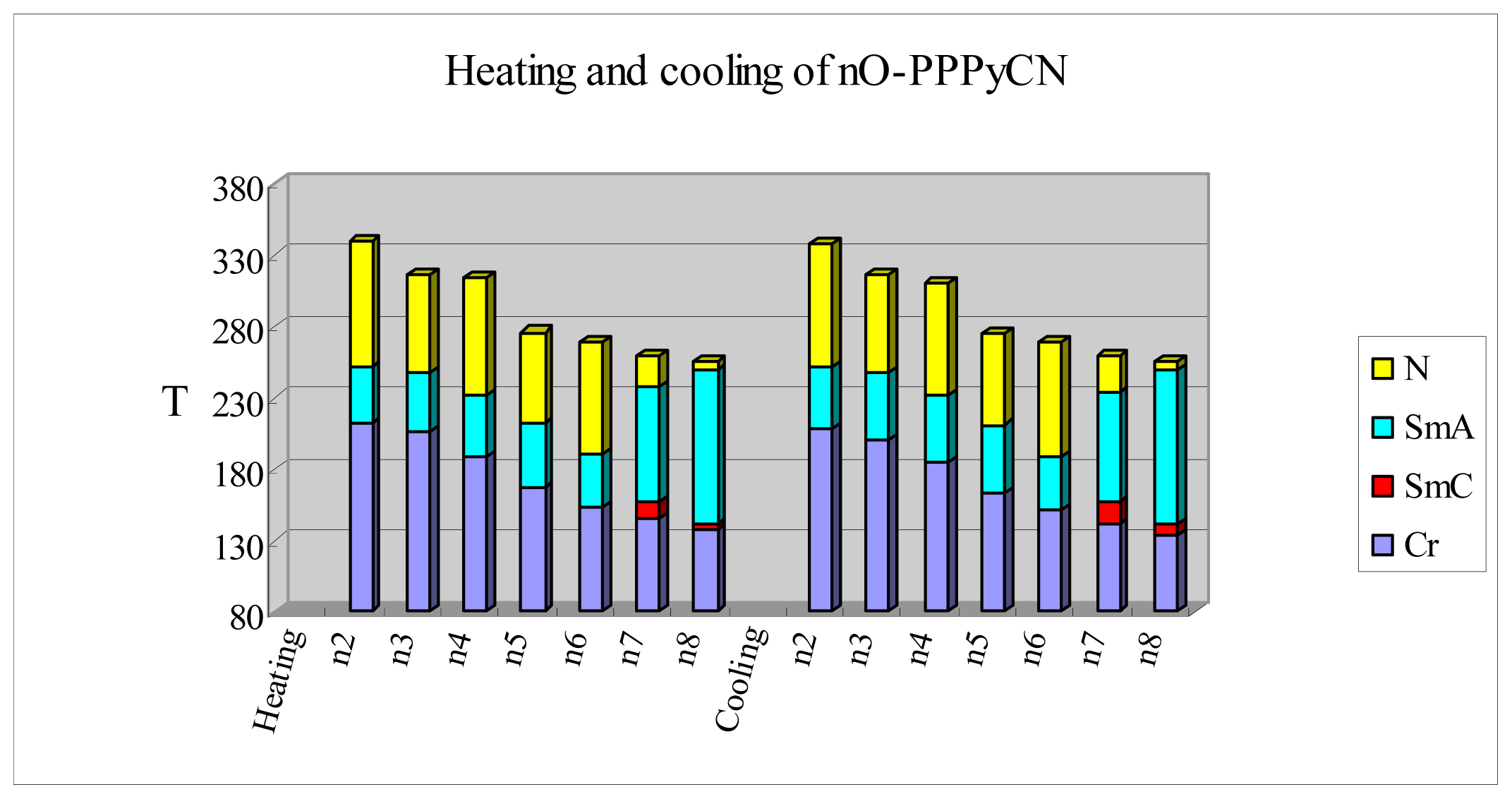
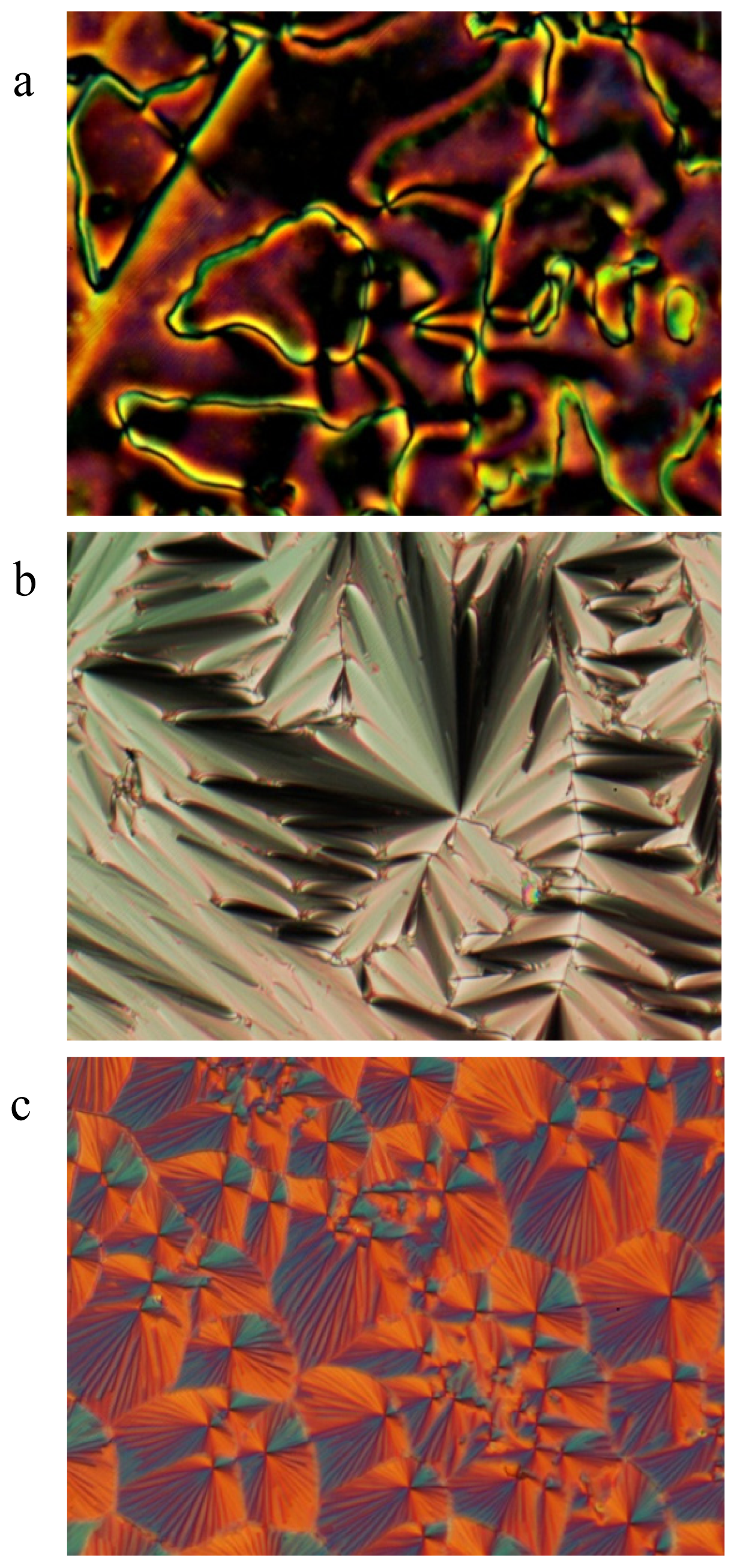
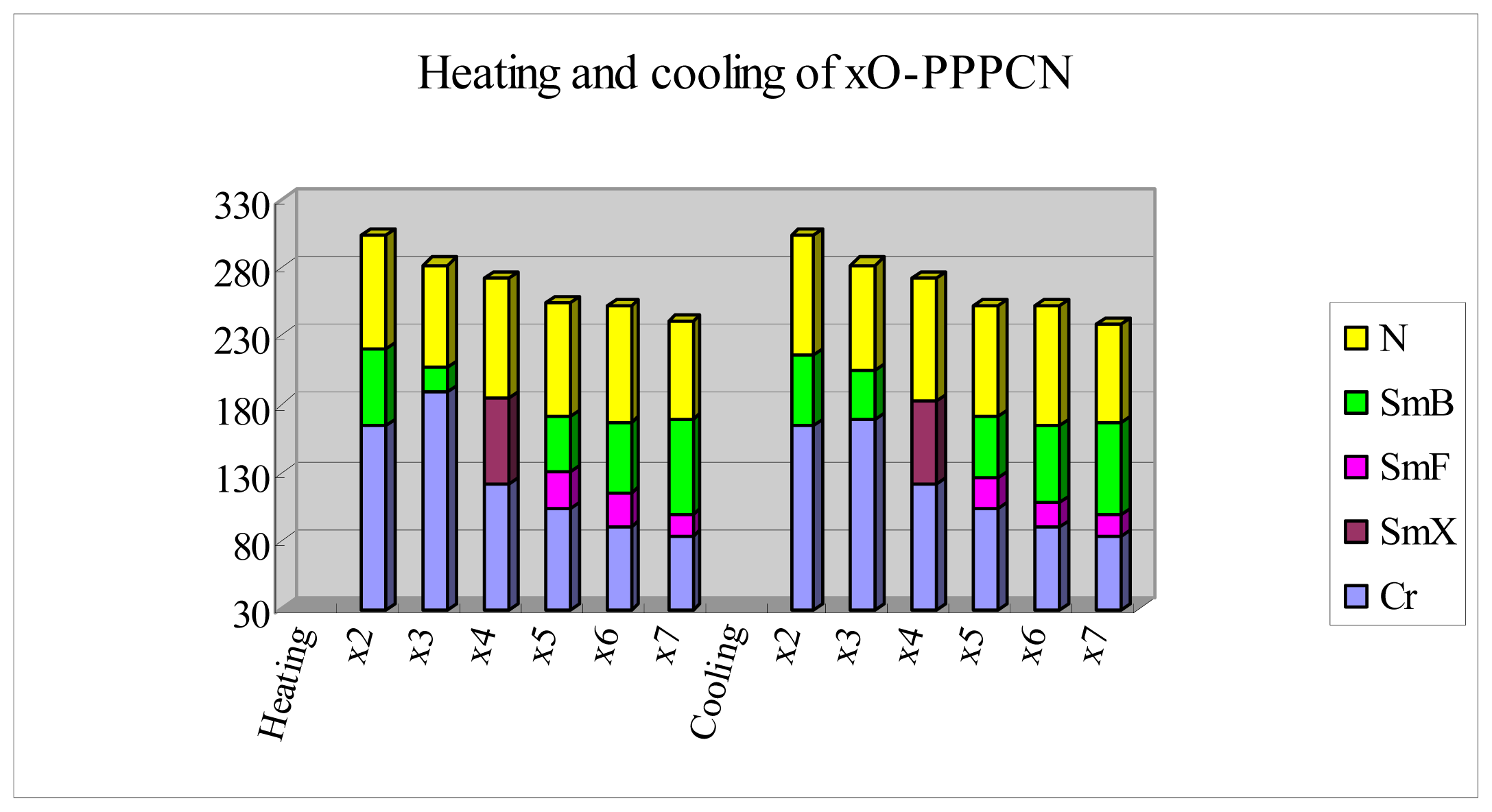

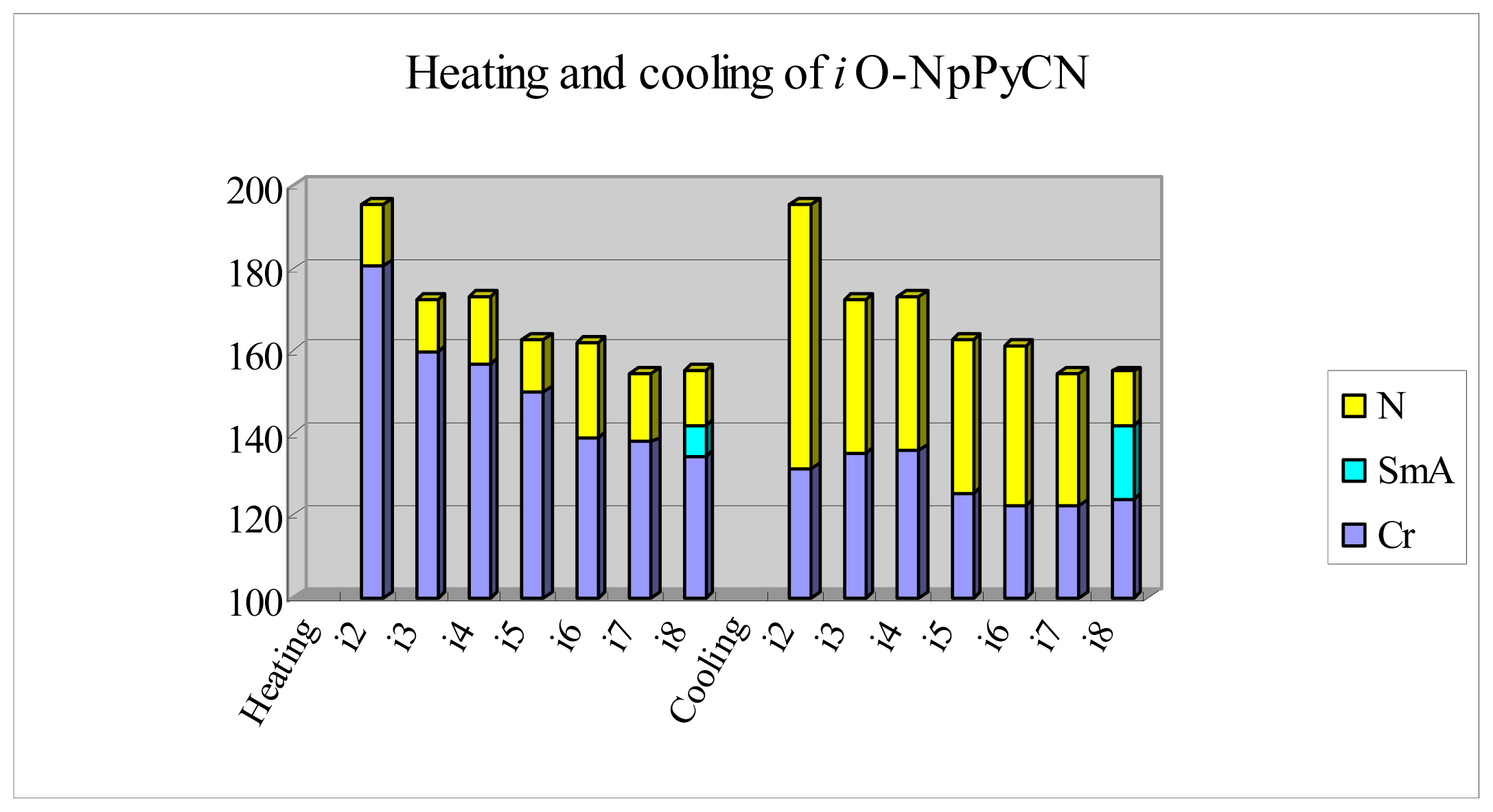
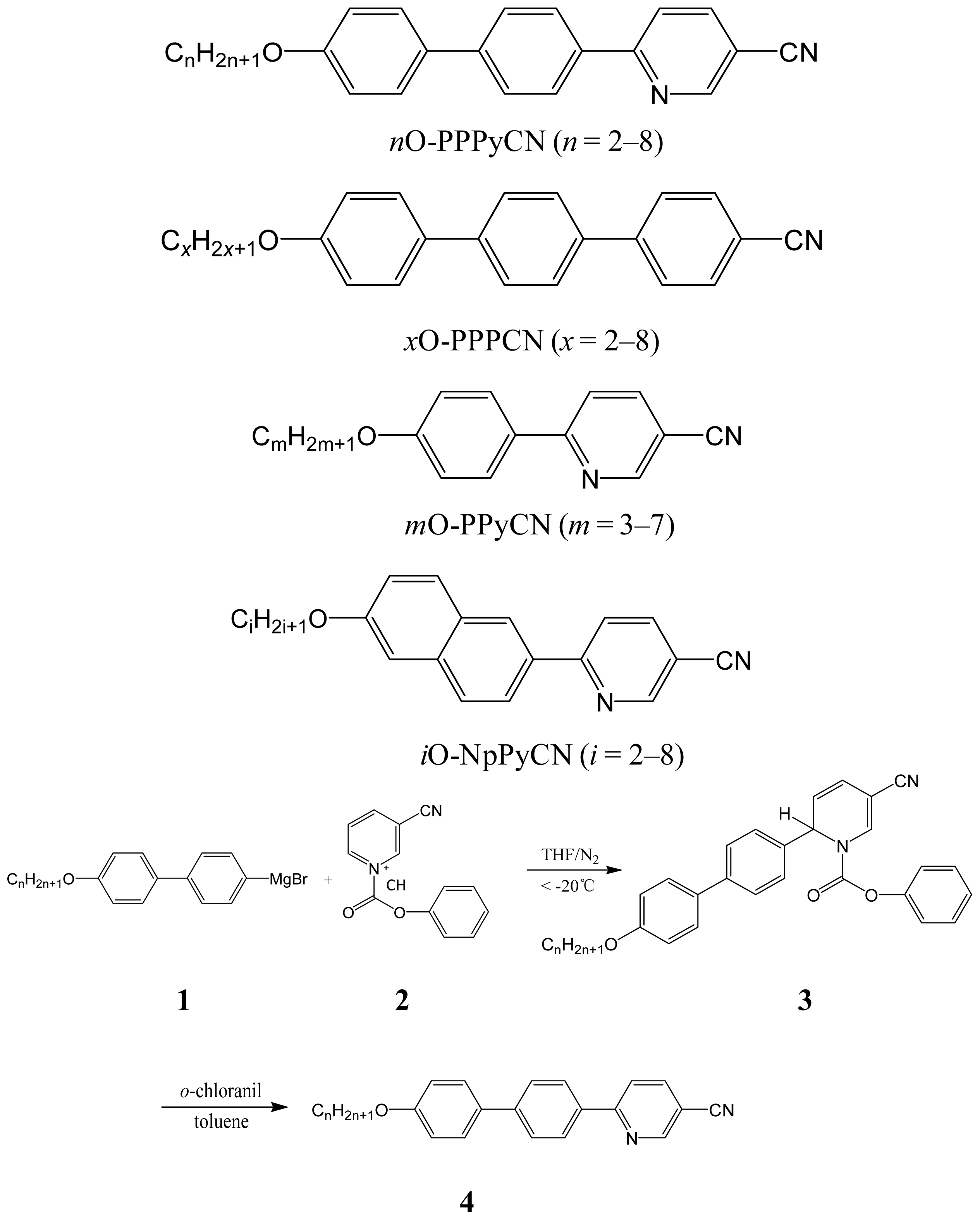
| Entry (n) | Alkyl group | Yield a(%) |
|---|---|---|
| 2 | Ethyl | 69 |
| 3 | Propyl | 47 |
| 4 | Butyl | 33 |
| 5 | Pentyl | 39 |
| 6 | Hexyl | 38 |
| 7 | Heptyl | 36 |
| 8 | Octyl | 34 |
| Compound nO-PPPyCN (n) | Phase transition temperatures (°C) and theircorresponding transition enthalpies (kJ·mol−1) | |
|---|---|---|
| Heating | Cooling | |
| 2 | Cr 212.4(8.72) SmA 251.2(2.14) N 340 a I | I 338 a N 250.8(2.05) SmA 208.8(8.25) Cr |
| 3 | Cr 206.3(12.02) SmA 247.7(2.93) N 317 a I | I 316 a N 247.1(2.94) SmA 201.4(11.36) Cr |
| 4 | Cr 188.3(~12.19 b) SmA 231.7(1.53) N 314 a I | I 310 a N 231.3(1.23) SmA 184.1(~12.98b) Cr |
| 5 | Cr′ 157.9(7.33) Cr 167.4(7.51) SmA 211.7(0.73) N 276.2(0.58) I | I 275.7(0.64) N 211.3(0.78) SmA 163.8(~7.56 b) Cr 150.6(7.15) Cr′ |
| 6 | Cr′ 145.3(5.10) Cr 153.6(8.82) SmA 189.9(0.63) N 269.3(0.92) I | I 268.8(0.77) N 189.6(0.16) SmA 150.8(~8.58 b) Cr 133.6(4.17) Cr′ |
| 7 | Cr′ 130.2(3.49) Cr 146.6(7.18) SmC 159.2(0.39) SmA 240 c N 260.8(0.55) I | I 260.4(0.58) N 235 c SmA 159.0(0.58) SmC 142.9(6.93) Cr 109.3(3.01) Cr′ |
| 8 | Cr′ 126.5(6.21) Cr 137.2(9.87) SmC 141.6(0.72) SmA 250.0(0.81) N 256.3(1.35) I | I 255.9(1.09) N 249.7(0.56) SmA 141.2(0.66) SmC 133.6(~9.48 b) Cr 107.5(4.68) Cr′ |
© 2013 by the authors; licensee MDPI, Basel, Switzerland This article is an open access article distributed under the terms and conditions of the Creative Commons Attribution license (http://creativecommons.org/licenses/by/3.0/).
Share and Cite
Chia, W.-L.; Lin, X.-M. Synthesis and Thermotropic Studies of a New Series of Teraryl Liquid Crystals 2-(4'-Alkoxybiphen-4-yl)-5-Cyanopyridines. Int. J. Mol. Sci. 2013, 14, 18809-18823. https://doi.org/10.3390/ijms140918809
Chia W-L, Lin X-M. Synthesis and Thermotropic Studies of a New Series of Teraryl Liquid Crystals 2-(4'-Alkoxybiphen-4-yl)-5-Cyanopyridines. International Journal of Molecular Sciences. 2013; 14(9):18809-18823. https://doi.org/10.3390/ijms140918809
Chicago/Turabian StyleChia, Win-Long, and Xue-Ming Lin. 2013. "Synthesis and Thermotropic Studies of a New Series of Teraryl Liquid Crystals 2-(4'-Alkoxybiphen-4-yl)-5-Cyanopyridines" International Journal of Molecular Sciences 14, no. 9: 18809-18823. https://doi.org/10.3390/ijms140918809




